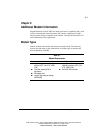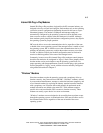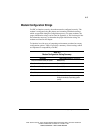
6-8
Additional Modem Information
Writer: Caroline Juszczak Project: Compaq Integrated Remote Console User Guide Comments: 281862-002
File Name: G-CH06.DOC Last Saved On: 11/20/98 4:17 PM
COMPAQ CONFIDENTIAL - NEED TO KNOW REQUIRED
Data Compression
Most high-speed modems also try to negotiate a compression protocol such as
v.42 bis or MNP5 upon establishing a connection to another modem.
Compression settings do not effect the ability to connect to IRC. However,
negotiating such a protocol is advantageous, since it greatly accelerates
responses from the server, particularly in remote console mode. Typically,
compression is normally negotiated, unless it is explicitly turned off on either
modem or the modems are incompatible. Typical AT commands to configure
compression include &K, %C, &E, and S-Register settings. Refer to your
modem’s AT command reference for more details.
Response Codes
The way a modem responds to commands and events is also highly
configurable. Through AT command strings, the modem can be instructed to
communicate this information numerically or through verbal descriptions. For
instance, based on its configuration, the modem may return “RING” in
response to an incoming call, or the number 2. In addition, the modem can be
configured return varying levels of information in several different formats.
Since modems vary greatly in how and what they send in response to event,
IRC does not use modem response codes when communicating with the
modem. Consequently, it does not matter what response code format it chosen
or what is communicated in the response codes. IRC uses the modem control
signals to determine events such as connect and ring.
Response code format commands are important, however, if you are sharing the
modem with the operating system. In this case, IRC must have the modem
configured to respond in a way that the operating system will expect and
understand. See Appendix A for instructions in how to determine how the
operating system has configured the modem under Windows NT 4.0.
There are several different AT commands on each modem to configure
different attributes of the response codes. Typical AT commands used to
configure the response codes include, V, \V, W, X, Q, &A, and S-register
settings (particularly S95). Refer to your modem’s AT command reference for
more details.


















